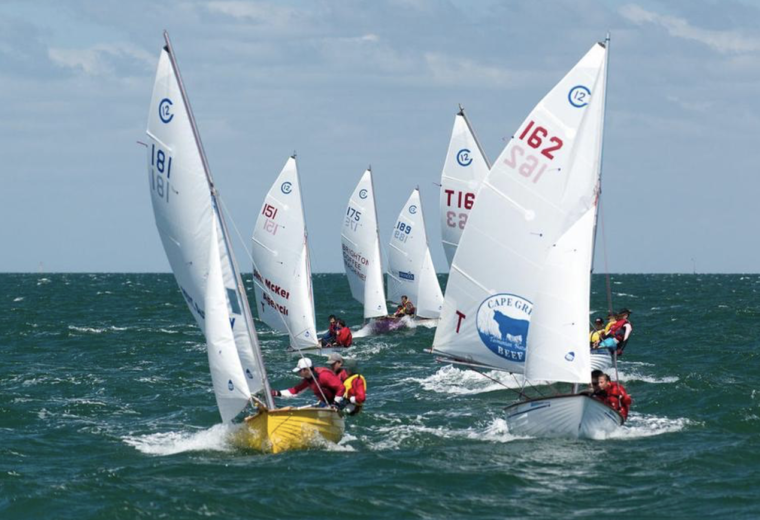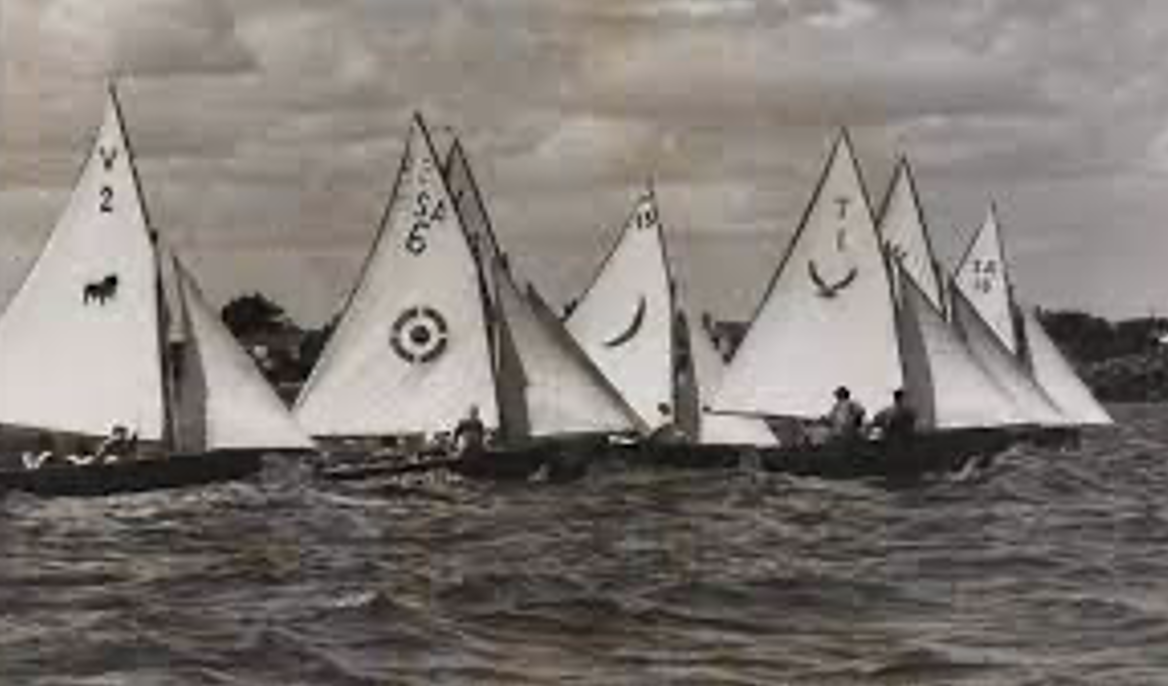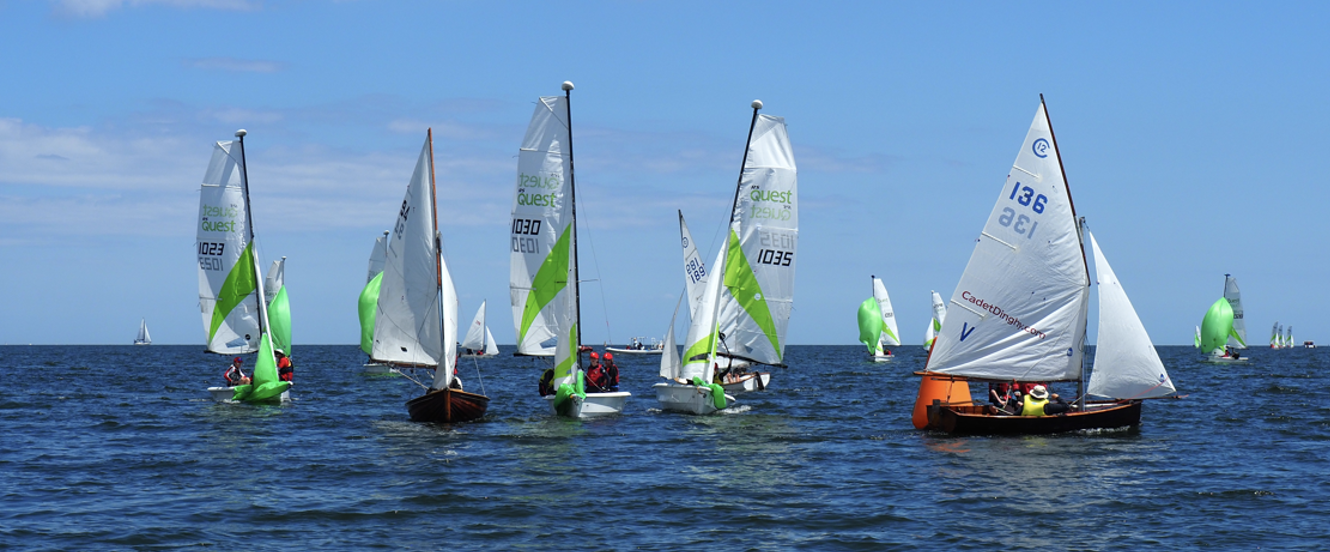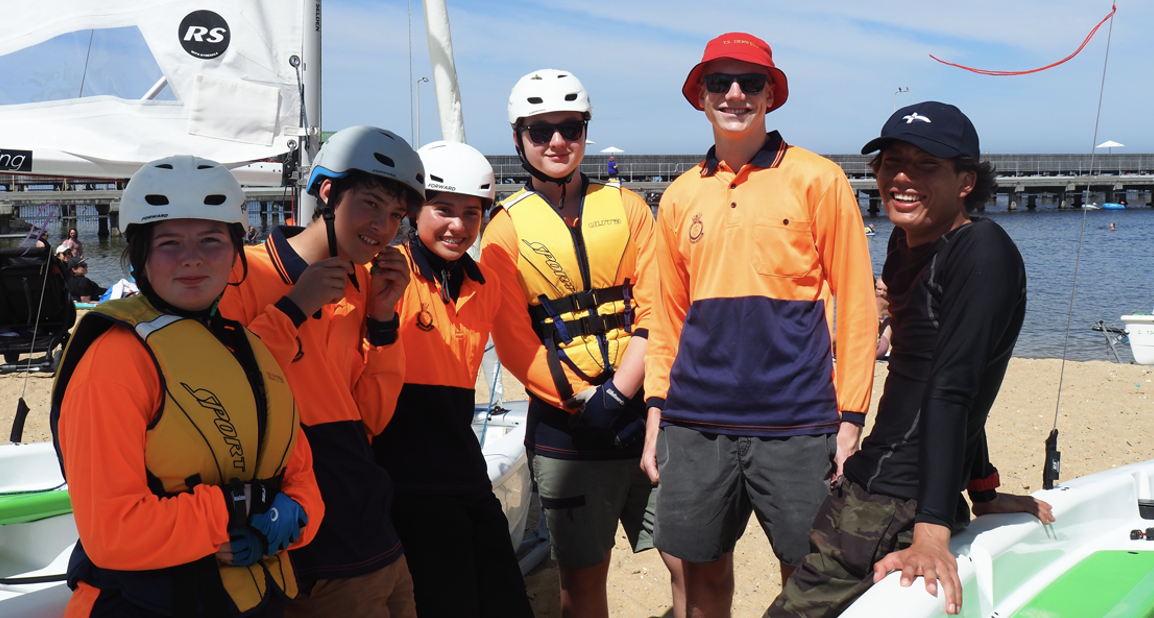Australian 12ft Cadet Dinghy 100th Anniversary Regatta


Main photo: Strong north west winds and relatively flat sea make for a quick run from the top mark, having fun and under control. 85th Stonehaven Cup, RMYS – Photo Francisco DeSilvestro
Where it all began
You can sit in the lounge or bar of any yacht club in the world and the discussion will usually end up debating the relative merits of one class or style of boat over another. The fact is that boat design is always a compromise of a range of conflicting requirements or aspirations. Speed, comfort, stability, ease of use etc. In the early 1920’s such a discussion occupied the minds of a bunch of skiff sailors around the yacht club bars in Sydney – they needed a dinghy that would be the basis of a training platform for getting kids into sailing, and especially developing skills required for potential recruits as crew on the famous skiffs of Sydney Harbour. I have a mental picture of the sort of discussion that would have taken place with the same passion and fervour that we hear today about other boats and classes, over 100 years down the track.
 From a lot of ideas and no doubt dozens of sketches (no computers in those days!) a gentleman called Mr A.C. Barber penned the lines of a dinghy, bringing together all the ideas floated in these most certainly very animated discussions. He recorded these thoughts and called it the One Design 12Ft Cadet Dinghy.
From a lot of ideas and no doubt dozens of sketches (no computers in those days!) a gentleman called Mr A.C. Barber penned the lines of a dinghy, bringing together all the ideas floated in these most certainly very animated discussions. He recorded these thoughts and called it the One Design 12Ft Cadet Dinghy.
A timber boat with full lines and room enough for three kids and lots of sail for some exciting sailing in all conditions. Clinker style timber planked hull (also referred to rather disparagingly as “weather-boards) usually a strong lightweight timber such as Western Red Cedar. Heavy steel centreplate, huge spade rudder, dipping lugsail gaff mainsail, jib out the front on a 3 foot bowsprit, and a very generous symmetrical spinnaker. All up, just the right amount of gear to ensure that even the most reluctant participant learned something about bits of it. I am not sure that a wind range was formally agreed to in the early days, but if it got to 25 knots and crews were already on the water, racing usually continued.
This design was first adopted by the Royal Prince Alfred Yacht Club, NSW, for youth training and racing in 1922. In 1924 the first formal interstate event was a race between NSW and Tasmania, in Hobart, the event was a draw between Mayfly (Tas) and Penguin (NSW) (they didn’t have sail numbers then, boats were identified with a symbol or logo on the sail). In 1927 Lord Stonehaven Governor General of Australia deeded the ‘Cup’ in his name to encourage friendly interstate competition between participating clubs of the Commonwealth.

Competition was very fierce, as most yacht racing ends up being, and many builders were very creative in stretching the interpretation of how you should build a timber 12 Ft Cadet, improve performance, just that tiny little bit, and still meet the strict class standard template. Many timber Cadet dinghies were built, but only 148 wooden boats got past the measurer, the last wooden boat to be formally measured was C148 ‘Kittiwake III’, built by Muirs in Tasmania in 1976.
Legends among Boats
Some of the timber boats acquired legendary status among the crews – C94 ‘Fayre’ built by Botterill in 1960; C126 ‘Venom’ also built at the Muirs yard; C127 ‘Kittiwake II’ another Muirs masterpiece; C128 ‘Avenger’ built in 1964 by Binks; C130 ‘Maple Leaf’ built by Jack Guiterrez; C133 ‘Pandora’ launched in 1965, C136 ‘Omen’ launched in 1966; C138 ‘Red Jacket II built by Muir; C146 ‘Zest’ built by McFarlane in 1971; and many others that may not have seen as much success on the water, but still much loved by their crews. The best news of all is that most of these gems of our sailing history are still with us today. Some are maintained in perfect condition and others that have required major rebuilding to bring them back to life.
Maintaining a fleet of timber boats, sailed hard every weekend, occasionally coming together by over enthusiastic competitors, was a burden to fleet managers. Much to the dismay of many, a fiberglass version was designed, replicating the key features of hull shape from the best performing timber boats, and more disturbing for the purists, fitted with a sloop rig on an aluminium mast. The first fibreglass boat was Cadet 149, ‘Ayden’ built by Stejcraft in 1976. The second fiberglass boat also built by Stejcraft in 1977, was C150 ‘Little Leura’ and raced in the Invitation Race of the Stonehaven Cup regatta in Adelaide in that year to highlight the merits of the fiberglass boat, proving that it wasn’t to be the end of the class.
Such was the success of this humble little dinghy that here we are 100 years on, celebrating the 100th anniversary of the class. There have been a few changes along the way – in the 1970’s the fiberglass hull that reduced maintenance costs and a safer platform (from a duty of care perspective), the Bermudan rig which is easier to set up correctly, buoyancy tanks to enable easy righting after a capsize thus not ending the days’ racing. However, after these momentous changes, the key attributes remained in the specification – three kids in a boat, sharing adventures, writing their own ‘war’ stories and building teamwork and lifelong friendships. The various 12 Ft Cadet youth sailing programs around the country built strong community minded sailors.
Key milestones in the history of the 12Ft Cadet regattas include:
- In 1946 RBYC became the Trustee of the Stonehaven Cup, six states regularly contested the cup.
- In 1969 the Otto Meik Teams Trophy became part of the competition (awarded to the winning team comprising a set number of boats from each participating club)
- In 1974 The Andrew Linacre Memorial Trophy became part of the competition (awarded to the winner of the first invitational race)
- In 1999 The Jock Sturrock Memorial Trophy became part of the competition (awarded to the winner of the second invitational race)
- In 2002 the event became known as the Stonehaven Cup Regatta
This robust little dinghy was the core pillar of the youth sail training programs run at RBYC and many other sailing clubs around the country, where twelve Cadet dinghies were rigged and raced every Sunday during the season. The participants took advantage of the design concept of three teenagers in a boat. The program taught by experience on the water, with beginners going racing on their first day. Experienced kids taught the less experienced ones under the watchful eye of Australian Sailing accredited instructors, who supplemented this with on-shore training and on-water coaching.
Transition
After a detailed study of the requirements of the youth sailing programs at various clubs around the world, the RS Quest was proposed as the most appropriate style of boat as a replacement for the 12Ft Cadet, that met the critical attributes of the Cadet. In 2018 the new RS Quest Dinghy fleet was displayed and proven in a separate invitational series, conducted alongside the 89th Stonehaven Cup, at RMYS.
In 2019, at the 90th Stonehaven Cup, the RS Quest Dinghy replaced the 12Ft Cadet Dinghy, and the Three Crew Open Series was launched to fit the scope of the new class.
Celebrating 100 years
In 2024, the centenary year of the 12Ft Cadet, the Australian 12Ft Cadet Dinghy 100th Anniversary Regatta was held in conjunction with the 94th Stonehaven Cup Regatta at RBYC, in Victoria. Youth sailors from four states contested the coveted Stonehaven Cup in 22 Quest dinghies, this was a record number of dinghies competing for the Cup.
A highlight of this regatta was the participation of the Australian Navy Cadets for the first time, with representatives from Flotillas across the country – some all the way from Perth and even central Queensland – eight teams in all, each comprising four or five sailors. We also had two crews from the Lake Ginninderra Sea Scouts in the ACT; two teams from King Island Boat Club; three teams from RMYS and of course the crews from RBYC – over 70 young sailors and plus all their support crews.
At the same time, on the same course, RBYC ran the 12Ft Cadet Dinghy 100th Anniversary Regatta with over 30 sailors of unspecified age!
Twenty boats were entered with an even split between the ‘new’ fiberglass boats and the gaff rigged timber boats that have been carefully stored in sheds around the country.
One fantastic example is C126 ‘Venom’ – she has been stored for the last 20+ years, hanging in the bar at the Royal Melbourne Yacht Squadron! She was gently released from the bindings that held her up in the ceiling, filled with water to assist the timbers to ‘take up’ and prepared for racing once again. What a story in its own right! With so many serious ‘old salts’ competing, in boats that they sailed in as teenagers, the stories on the rigging lawn and in the bar afterward recounted legendary days that only got better with the re-telling.

The Regatta/s
Both competitions had a challenging time with fluky, light winds each day making it real tough for the Race Officer, Paul Pascoe and his team.
As is always the case in the Stonehaven Cup regatta, there is a vast range of experience and skill, and consideration for each crews’ respective abilities is a highlight. Help was generously provided to anyone who needed it when they needed it. Great sportsmanship was demonstrated at every tack or gybe.

A highlight for this correspondent was when, on the third day of racing, after just four races, the entire Quest fleet hit the start line as one. Everyone was learning at a remarkable pace. Well done to all.
By the time the fleet arrived at the first windward mark, it emerged that we had three distinct categories of race within the races – those with a tonne of experience in the first third, then the emerging sailors in the next third, and the beginners bringing up the rear. The Australian Navy Cadets were somewhat disadvantaged by the fact that their boats were not rigged with a spinnaker, so they did appear to be behind the game, however, they had their own keenly contested competition in the ‘non-spinnaker’ division.
The Stonehaven Cup regatta is not just about the racing on the water. It is also about making new friends, and if the 100th Anniversary of the 12Ft Cadet is any indication, friends for life.

Congratulations to all the participants – you’re all winners.
Special congrats to the winning crew for Stonehaven Cup 2024 – the RMYS crew of Hayden Gold, Ryka Fregan, and Eliza Davidson sailing Q1030 ‘Scarlett’. Second by just a couple of points was the RMYS crew of Ashley Wahlqvist, Zoe Vlasic, Myra Barber sailing Q1035 ‘Heather’ and in third place by just one point the RBYC crew of Nathan Stanford, Edward Jukes and Oliver Martin on Q1472 ‘John Akhurst’.
And to top all that off, the RMYS team took out the Otto A. Meik Perpetual Teams trophy. A great job from all involved.

The Once in a Century Competition
The 12ft Cadets sailed on the same course starting at an appropriate time behind the Quest sailors. They had some of the most accomplished sailors in the country sailing them and the racing was intense. Indeed, a lot of talk about sheep stations and cases of beer!
It became abundantly clear that the crew to beat was C127 ‘Kittiwake II’ – helm Nick Chapman with Martin O’Donohue and Virginia Tait (Faul) as crew on 8 points. These guys gave the rest of the fleet a sailing lesson, whether challenged by tide, light winds and no wind, the occasional steady breeze, or simply great tactics.
Occupying the second step on the podium was the crew of Douglas Linacre and Ross Kennedy sailing C174 ‘Catani’ representing RQYS on 16. These guys were followed by C176 ‘MayFly III’ crewed by Travis Read, Jessica Slade and Will Logan representing Tasmania on 17 points.

While the sailing was fun, the most memorable part of the regatta was not the sailing, but the gathering of mates across the generations, all with a common connection – the lovely little boat, our Australian 12Ft Cadet Dinghy. At the end of the day, even the distinction between timber and fiberglass was forgotten. It’s just a Cadet and while anyone can sail one, you have to sail them well to win a race.
Organising an event such as this is a huge task and many thanks to everyone from all the participating clubs for making this, the 94th Stonehaven Cup regatta, and the special, once in 100 years celebration of the Australian 12Ft Cadet such a memorable experience for everyone.
Full results for both fleets may be found here:
Ray Smith
RBYC

